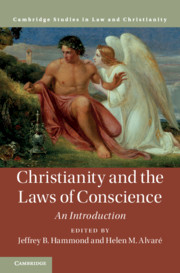Book contents
- Christianity and the Laws of Conscience
- Law and Christianity
- Christianity and the Laws of Conscience
- Copyright page
- Dedication
- Contents
- Contributors
- Acknowledgments
- Introduction
- Part I Themes in Understandings of Conscience in Christianity
- Part II Conscience According to Major Figures and Traditions
- Part III Applied Topics in Law and Conscience
- 15 Liberty of Conscience, Free Exercise of Religion, and the US Constitution
- 16 Religious Conscience Protections in American State Constitutions
- 17 Forced Conformity or Accommodation?
- 18 Christian Conscience and Sexual Expression Rights
- 19 Conscience and the Roman Catholic “Just War” Tradition
- 20 Institutional Conscience, Corporate Persons, and Hobby Lobby
- 21 Religion, Conscience, and the Law
- Index
- References
16 - Religious Conscience Protections in American State Constitutions
from Part III - Applied Topics in Law and Conscience
Published online by Cambridge University Press: 12 June 2021
- Christianity and the Laws of Conscience
- Law and Christianity
- Christianity and the Laws of Conscience
- Copyright page
- Dedication
- Contents
- Contributors
- Acknowledgments
- Introduction
- Part I Themes in Understandings of Conscience in Christianity
- Part II Conscience According to Major Figures and Traditions
- Part III Applied Topics in Law and Conscience
- 15 Liberty of Conscience, Free Exercise of Religion, and the US Constitution
- 16 Religious Conscience Protections in American State Constitutions
- 17 Forced Conformity or Accommodation?
- 18 Christian Conscience and Sexual Expression Rights
- 19 Conscience and the Roman Catholic “Just War” Tradition
- 20 Institutional Conscience, Corporate Persons, and Hobby Lobby
- 21 Religion, Conscience, and the Law
- Index
- References
Summary
Michael DeBoer identifies five periods in US state constitutions’ protections of religious conscience. The first and second periods, from roughly 1776 to the 1830s, saw state constitutions grant solicitude to religious conscience and free exercise. The end of the second period saw all states abolish church establishments. The third period, from the 1830s to the 1920s, saw many new states in the Union, and their constitutions were largely protective of religious conscience. The fourth period, from the 1920s to the 1970s, saw the incorporation of the US Constitution’s religion clauses against the states, and new or amended state constitutions’ textual conscience protections borrowed language from the US Constitution. Some state interpretations of conscience-related issues closely mirrored those from the Supreme Court. In the fifth period, from the 1970s to present, some states were protective of religious conscience, while other states have hewed to religion-harmful interpretations occasioned by the Supreme Court’s case of Employment Division v. Smith. In this period, some states passed Religious Freedom Restoration Acts (RFRAs) modeled after the federal statute.
Keywords
- Type
- Chapter
- Information
- Christianity and the Laws of ConscienceAn Introduction, pp. 305 - 335Publisher: Cambridge University PressPrint publication year: 2021

